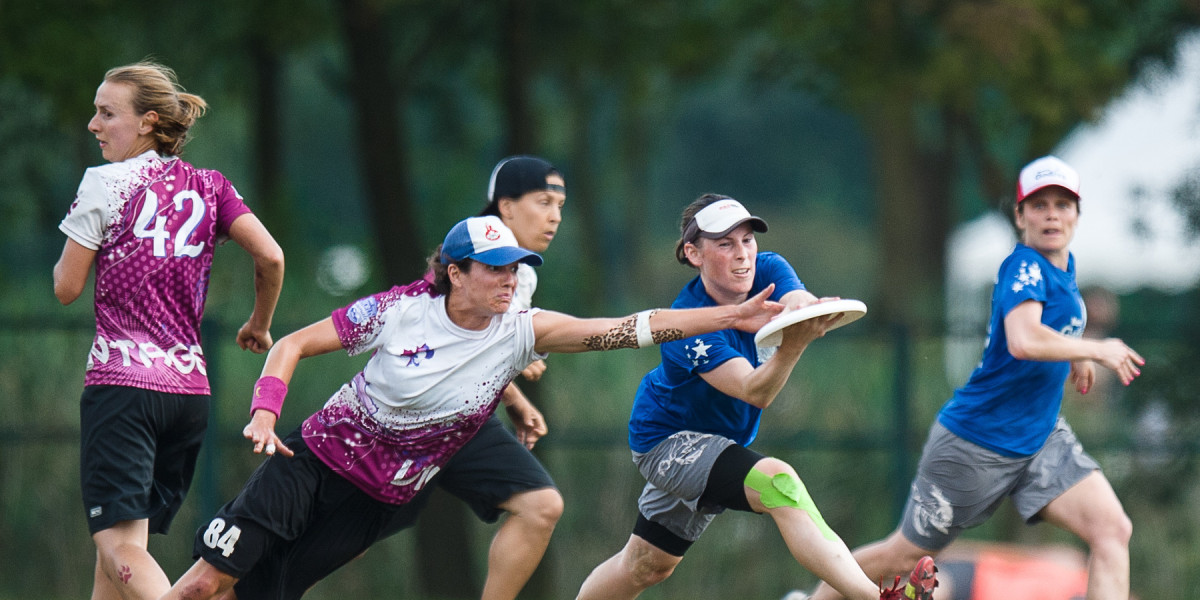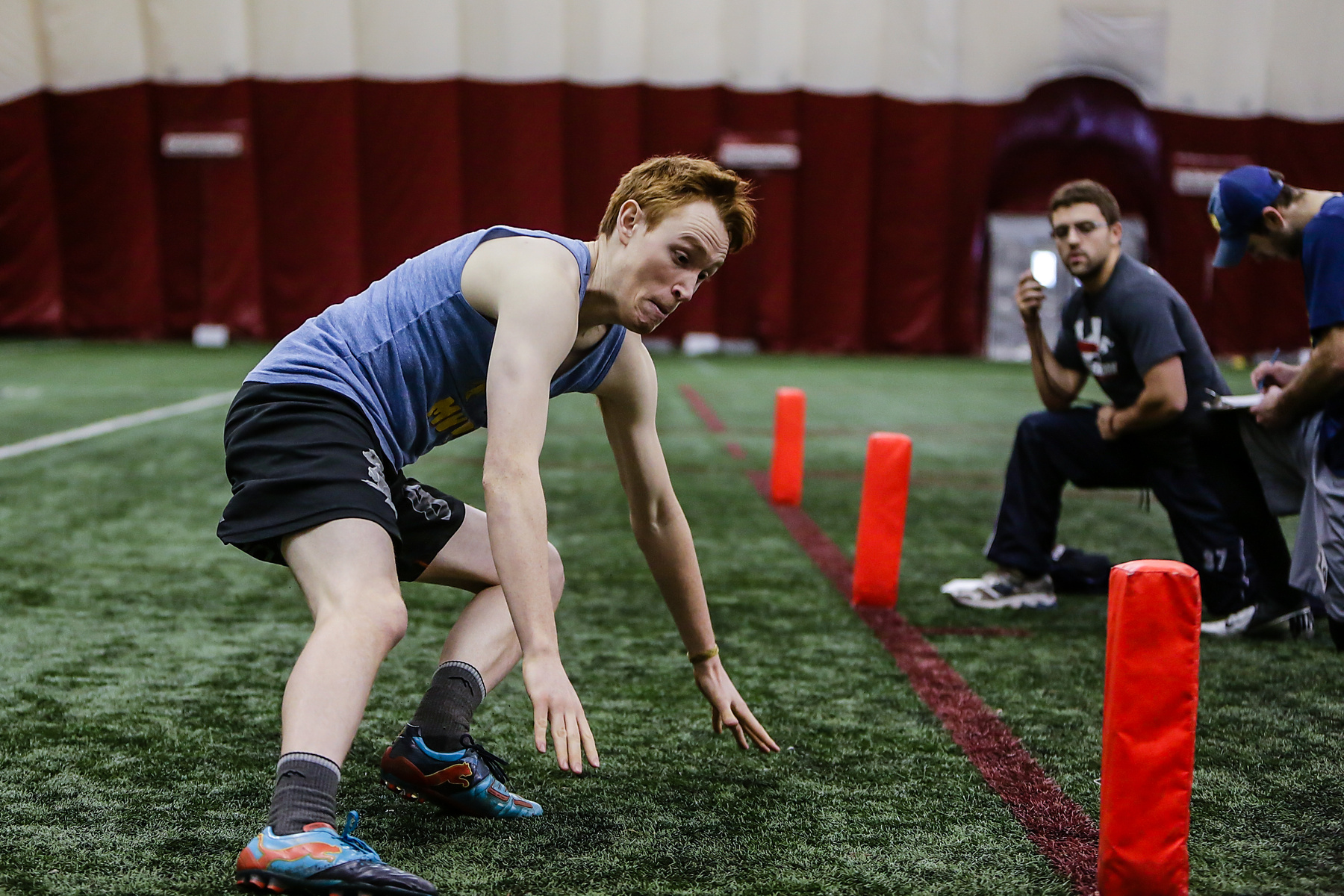 Françoise Delisle (Vintage #84) layout bid vs Godiva, WUCC Women's Masters Finals (Kevin Leclaire - UltiPhotos.com)
Françoise Delisle (Vintage #84) layout bid vs Godiva, WUCC Women's Masters Finals (Kevin Leclaire - UltiPhotos.com)
In this 6-part series, Brent Steepe, professional personal trainer of 22 years, discusses his deviation from the fitness industry and what ultimate athletes need for future decades of elite play.
As training information and services become more readily available, people are striving to take control of their personal fitness. Their goals might be to prepare for the upcoming season, to recover from injury, or just to satisfy a new years resolution. Some people are trying to reach maximum performance levels for their professional debut, while our youngest players are inspired by the possibility of playing in the Olympics someday. There is always a dream, but there is also a corresponding journey. There are many roads available to achieve your goals, especially if performance and progress are the focus, but there are very few programs that take you beyond one-sided goals with a process that doesn’t harm some other area of health.
This is seen in shows like “The Biggest Loser”, where transformations are impressive but the “winners” often revert to their pre-transformation selves–and develop health problems along the way. While TV shows have obligations to make their storylines entertaining, the trainers and experts that appear also serve the mainstream fitness industry. The average person is more likely to sample diets or exercise plans featured by high-profile clients. “If it worked for me, it can work for you!” Unfortunately, that advice doesn’t take into account that all people need individualized attention in order to reach their potential. Each person is in a completely different state of performance, efficiency, recovery, etc.
Because of this industry methodology, we continue to see all types of athletes, even professional athletes, sustain injuries that they blame on their previous conditions or age. When we talk about ultimate injuries, they are often so similar and frequent we ask a teammates or alumni who they saw for their ACL surgery, or how they taped their ankles. Within a recent study sample, we can calculate that over 60% of injuries are a performance-based system failure, while only about 34% come from collisions or environment. Theoretically, this means if everyone truly trained for their required performance level we could cut injuries to about one third of the current rate. Considering the additional body control and reflexes to avoid collisions, not to mention a neutral body position to recover from uneven surface strain, this rate could drop even more. I think that is a goal worth pursuing, and I would like to contribute my experience and knowledge to the ultimate community to help.
Understanding Process vs. Progress
Have you ever wondered why, although they train side-by-side with the same experts, some elite athletes perform better than others? Some sources will claim genetics, while others conclude that environment and developmental history are the primary factors. After 22 years of experience, I can assure you that each of these are factors to consider, but neither comprise the entire picture. Even more important is the application of the training process, unique to the individual, taking into account all factors for performance, recovery and mental health.
For our purposes, we will define process, progress, and fitness in the following ways:
Process: The methodology by which one achieves fitness.
Progress: A series of fixed points of measurement and comparison to goals or standards.
Fitness: The body’s ability to return to a neutral state after an abnormal stress or force is applied, while maintaining peak performance.
When seeking fitness and performance, many choose to focus on the concept of progress in terms of measurements: faster 40 yard dashes, higher vertical jumps–the glory numbers. The idea that “the end justifies the means” is common in our culture today, but is not acceptable for achieving true fitness. Why should the pursuit of fitness be paramount? Simple: Do you want to play at your peak for just 5 years, or for 10+ years? Fitness is not a destination, but a process of continuous refinement. It allows athletes to play the sport they love to the best of their ability, and for much longer than they could if they only considered progress.
The challenge for all athletes to embrace is to set a process to achieve progress that will support a long-lasting career, regardless of any level or division. Monitor the process, be an active participant in its formation, and learn to understand the cues of your body as you prepare for each and every contest. Regardless of your sport or activity, this article series will explain how to learn what your body needs and how to seek those things with your personal state in mind. Otherwise, your personal fitness could be more like hitting the lottery than receiving a regular paycheck.

(Alex Fraser – UltiPhotos.com)
Road Trip!
With that groundwork in place, let’s look at what the process looks like for a variety of ultimate players trying to play their best in the long term. Here is a checklist for asking yourself questions to fill in gaps of knowledge before creating your conditioning process.
- Find Your Coordinates
In order to figure out how to get somewhere, you must first know where you are. Some may simply google “ultimate training” and find skater squats or kettlebell recommendations without first considering their own body’s capabilities. As tedious as it sounds, an athlete of any level should consult with a certified (and experienced!) fitness expert to work through the mindset and find a process that fits their current state and desired goals. Skipping this critical step could create a risky window of opportunity for injury.
- Update Your Map
Creating a successful training program requires correct information regarding the basic factors of fitness: nutrition, hydration, activity, rest, and environment. Personal trainers should be personalized for you and personal to you. If they can not be honest about weak areas of knowledge or admit when they are experimenting, you might want to look for other experts who have clinical research already behind them. Information uninfluenced by specific equipment, supplements, or hype workouts is what you want to look for first. Without a correct road map, you are bound to get lost.
- Don’t Speed
Truly attainable goals at a biologically-natural pace are necessary if you want to gain and maintain true fitness. Accelerated development can open the body up to injury because of associated lack of control over new capabilities. If we know how to drive a car, but are given a tractor-trailer or tank for our daily commute, how effective would we be? Desired attributes like neutrality, stamina, and oxygen transport cannot change overnight, and obtaining speed or vertical jump ability without them could result in system failure. Plan your process at least 6 months ahead of your season to be ready at the perfect moment.
- Read the Right Signs
As you move through programming, adaptation will be important. Extensive pain and excessive fatigue post-conditioning is a sign of damage, not improvement. The “no pain, no gain” lie is unfortunately still floating around, and athletes who follow that philosophy often crash and burn. Considering metrics like daily energy levels, mood, and neutrality-return-rate can help you better assess whether your body is happy. A happy body can work harder, and allows you to evaluate your ability to increase performance. Using a training log and recording things like hydration, nutrition, and rest can lead to understanding trends and identifying negative behaviors before they become true problems.
- Schedule Your Maintenance
Once your event or season is over, it’s time to continue the process–while transitioning into the next lane if you desire a new destination. Using the information you learned, understanding your body’s needs and characteristics, and reflecting on your performance, you will create even more effective processes for your progress in the future. For the people who struggle the most, that process may involve taking a year(s) off to widen your base, fully recover from a recurring injury, or find a new mindset to drive your desires. Wherever your destination might be, using the right resources and regulations can get you there with time.
Throughout this series, complex topics will be simplified for awareness purposes, not complete understanding. Biomechanics, as well as the body’s metabolic properties, are designed with great functionality in mind, so they involve many factors susceptible to optimization. In the next article I will cover advanced nutrition and hydration, each important to give your body the best combination of fuel for success.
Although true fitness and performance will range between demographics and bodies, one thing is certain: process trumps progress for lifelong athletes, whether they are recreational, collegiate, or professional. Understanding the components of a good process, then, should become the goal of each and every passionate athlete, regardless of your training level, if you desire to play your best in the long term.










Comments Policy: At Skyd, we value all legitimate contributions to the discussion of ultimate. However, please ensure your input is respectful. Hateful, slanderous, or disrespectful comments will be deleted. For grammatical, factual, and typographic errors, instead of leaving a comment, please e-mail our editors directly at editors [at] skydmagazine.com.